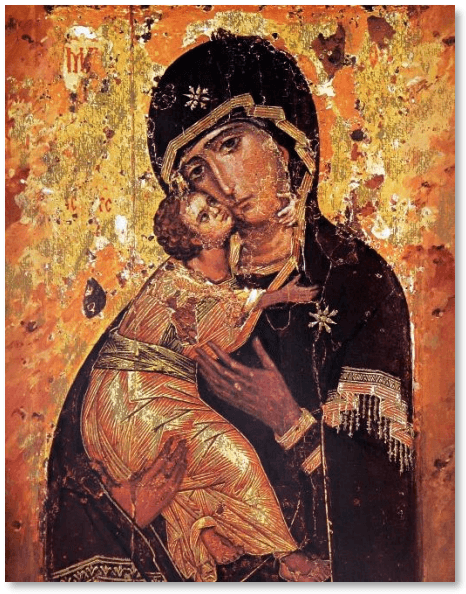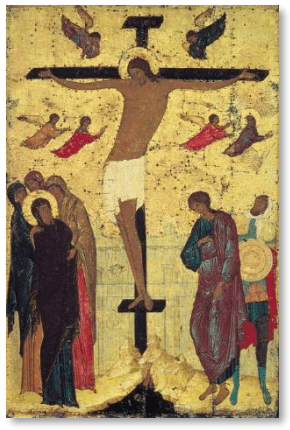The Place of the Theotokos in the Communion of Saints
Among the saints, Jesus’ mother Mary, called the Theotokos1 occupies a special place. We see this in the Church’s anaphora, cited above: we pray for all the saints, but “especially for our most holy, most pure, most blessed and glorious Lady Theotokos and ever-virgin Mary.” At every Dismissal of the church’s services, we invoke the intercession of the saints, but she stands at the head of the list, as the crown of the communion of saints. That is why we say, “May Christ our true God, through the prayers of his most pure Mother; of the holy, glorious and all-laudable apostles, of the holy and righteous ancestors of God, Joachim and Anna and of all the saints have mercy upon us and save us, for He is good and loves mankind.” We ask Christ to bless us through the prayers “of all the saints,” but our first thought is of “his most pure Mother.”
The Theotokos, our pre-eminent Saint

The Church’s devotion to the Theotokos eclipses its love for any of the other saints. Though she remains firmly anchored in the communion of the saints, in a sense she is in a category all by herself. Her image is the only saint found in every iconostas in every Orthodox Church, where it occupies a place of honor next to the icon of her Son. The Church sings her praises in many ways. A cycle of feasts, comparable to those of Christ, is found throughout the Church’s calendar: the feast of her Nativity on September 8, her Entrance into the Temple on November 21, her Meeting with Saints Simeon and Anna in the Temple on February 2, her Annunciation on March 25, and her Dormition or falling asleep in death on August 15. Specific prayers to the Theotokos are found in every Divine Liturgy, and in every Vespers service. In any Orthodox prayer book, several prayers are offered to her in daily morning and evening prayers. These all witness to her importance in the life of the Orthodox Christian.
Our love for the Mother of God is based upon two things, which find expression in a word uttered by her and her Son. First, we love her because she gave her assent to the incarnation of the eternal Logos. Upon being told by the Archangel Gabriel that she had been chosen to give birth in nine months to the Messiah by the power of the Holy Spirit, she responded by agreeing to this, despite the personal cost to her reputation when it was found she was pregnant out of wedlock. It was her assent, “Be it unto me according to your word” (Luke 1:38) that allowed the divine Word to enter time and space through her body, uniting human nature to Himself.
By her freely given assent, she became the anchor of our faith,2 and all that the Savior later accomplished for our salvation was built upon her prior assent. Our gratitude to Christ as our King and Savior also involves our grateful recognition of her part in the divine plan of salvation. She became the bush which burned with the fire of divinity and yet was not consumed (Ex 3:2). She became the living ark which contained the divine presence (Ex 25:22).
This means that Mary is unique among all the other members of the Church and of the communion of saints. Like all the other saints, she cries out, “My Lord and my God!” But unlike all the other saints, and like every mother, she also cries out, “My own child!” Alone of all her sex, she gave birth to her Creator. The abundant outpouring of hymnography praising her and celebrating this represents the Church’s ongoing attempt to absorb that single astonishing fact.
But unlike all the other saints, and like every mother, she also cries out, “My own child!” Alone of all her sex, she gave birth to her Creator. The abundant outpouring of hymnography praising her and celebrating this represents the Church’s ongoing attempt to absorb that single astonishing fact.
Secondly, our love for the Theotokos is also based upon her love for us. When He hung on the Cross, Christ saw both his mother and his beloved disciple (i.e., his close friend John) standing there together. He said to his mother, “Woman3 , behold your son.” And then to John, “Behold your mother” (John 19:26-27). Through these words Christ committed his mother into the care of his close friend since she had no other children to look after her, and from that hour, John took her into his own home.
These words have a deeper meaning: John the beloved disciple represents all the disciples of Jesus, and in giving Mary into the care of John as his mother, He was committing Mary into the care of His Church and thereby making her the mother of all the faithful. Mary’s maternal love for her Son overflows into her love for all her Son’s disciples. She loves us all for his sake, caring for us as a mother cares for her own children, and praying for us. We love her therefore, because by her prayers and intercession, she constantly proves herself to be our protector, our nourisher, the one who rescues us from affliction, and who prays for our repentance and forgiveness when we err and sin. That is why every Vespers and Matins service ends with the Church invoking her rescue and help: “Most holy Theotokos, save us!”—i.e., rescue us out of all our distress. As one of the entrance prayers says,
O blessed Theotokos, open the doors of compassion to us whose hope is in you, that we may not perish but be delivered from adversity through you, who are the salvation of the Christian people.
Footnotes
-
Theotokos is a Greek term meaning God-bearer or Birth-giver of God (Jesus). ↩
-
In the Vespers service, the Tone 1 verses on “Lord I call” ↩
-
Or, in more modern English, “Madam.” The term is not as rude as it might appear in English; but is a formal form of address. Compare Luke 12:14, where Christ addresses someone as “man”—in modern English, “sir.” ↩